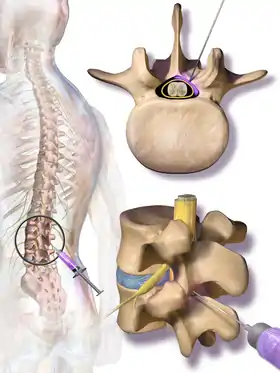Epidural steroid injection
| Epidural steroid injection | |
|---|---|
 Steroids are injected into the cerebrospinal fluid in the canal surrounding the spine. Nerves branch out from the spine. The nerve roots, which may be compressed, are at the base of the nerves. | |
| Specialty | Pain Medicine |
Epidural steroid injection (ESI) is a technique in which corticosteroids and a local anesthetic are injected into the epidural space around the spinal cord in an effort to improve spinal stenosis, spinal disc herniation, or both. It is of benefit with a rare rate of major side effects.[1][2]
Medical uses
Epidural steroid injection for sciatica and spinal stenosis is of unclear effect.[1] The evidence to support use in the cervical spine is not very good.[3] When medical imaging is not used to determine the proper spot for injection, ESI benefits appear to be of short-term benefit when used in sciatica.[4] It is unclear if ESI is useful for chronic pain after spinal surgery.[5]
Side effects
Major side effects are rare.[2] These include loss of vision, stroke, paralysis, or death when the corticosteroids are infected, as in a 2012 meningitis outbreak.[2][6] Another study found an increased odds of developing epidural lipomatosis, independent of body mass index (BMI) or other factors.[7]
Technique
Elective spinal injections should be performed with imaging guidance, such as fluoroscopy or the use of a radiocontrast agent, unless that guidance is contraindicated.[8] Imaging guidance ensures the correct placement of the needle and maximizes the physician's ability to make an accurate diagnosis and administer effective therapy.[8] Without imaging, the risk increases for the injection to be incorrectly placed, and this would in turn lower the therapy's efficacy and increase subsequent risk of need for more treatment.[8] While traditional techniques without image guidance, also known as blind injections, can assure a degree of accuracy using anatomical landmarks, it has been shown in studies that image guidance provides much more reliable localization and accuracy in comparison.
References
- 1 2 Shaughnessy, AF (15 February 2016). "Epidural Steroid Not Better Than Placebo Injection for Sciatica and Spinal Stenosis Pain and Function". American Family Physician. 93 (4): 315–6. PMID 26926820.
- 1 2 3 Schneider, B; Zheng, P; Mattie, R; Kennedy, DJ (August 2016). "Safety of epidural steroid injections". Expert Opinion on Drug Safety. 15 (8): 1031–9. doi:10.1080/14740338.2016.1184246. PMID 27148630. S2CID 27053083.
- ↑ Cohen, SP; Hooten, WM (14 August 2017). "Advances in the diagnosis and management of neck pain". BMJ (Clinical Research Ed.). 358: j3221. doi:10.1136/bmj.j3221. PMID 28807894. S2CID 29500924.
- ↑ Vorobeychik, Y; Sharma, A; Smith, CC; Miller, DC; Stojanovic, MP; Lobel, SM; Valley, MA; Duszynski, B; Kennedy, DJ; Standards Division of the Spine Intervention, Society (December 2016). "The Effectiveness and Risks of Non-Image-Guided Lumbar Interlaminar Epidural Steroid Injections: A Systematic Review with Comprehensive Analysis of the Published Data". Pain Medicine (Malden, Mass.). 17 (12): 2185–2202. doi:10.1093/pm/pnw091. PMID 28025354.
- ↑ Wylde, V; Dennis, J; Beswick, AD; Bruce, J; Eccleston, C; Howells, N; Peters, TJ; Gooberman-Hill, R (September 2017). "Systematic review of management of chronic pain after surgery". The British Journal of Surgery. 104 (10): 1293–1306. doi:10.1002/bjs.10601. PMC 5599964. PMID 28681962.
- ↑ Kauffman, CA; Malani, AN (April 2016). "Fungal Infections Associated with Contaminated Steroid Injections". Microbiology Spectrum. 4 (2): 359–374. doi:10.1128/microbiolspec.EI10-0005-2015. ISBN 978-1-55581-944-6. PMID 27227303. S2CID 42550449.
- ↑ Jaimes, Rafael; Rocco, Angelo (August 2014). "Multiple epidural steroid injections and body mass index linked with occurrence of epidural lipomatosis: a case series". BMC Anesthesiology. 14 (70): 70. doi:10.1186/1471-2253-14-70. PMC 4145583. PMID 25183952.
- 1 2 3 North American Spine Society (February 2013), "Five Things Physicians and Patients Should Question", Choosing Wisely: an initiative of the ABIM Foundation, North American Spine Society, retrieved 25 March 2013, which cites
- North American Spine Society (2011). "Diagnosis and treatment of degenerative lumbar spinal stenosis". Burr Ridge, Illinois: Agency for Healthcare Research and Quality: 104. Archived from the original on 25 March 2014. Retrieved 25 March 2014.
{{cite journal}}: Cite journal requires|journal=(help)
- North American Spine Society (2011). "Diagnosis and treatment of degenerative lumbar spinal stenosis". Burr Ridge, Illinois: Agency for Healthcare Research and Quality: 104. Archived from the original on 25 March 2014. Retrieved 25 March 2014.